How about exploring the
area of fabric painting a little?
This post is a little
experiment. Later this month I'm planning a project where painting
fabric could come in hand, so I wanted to see how it works
beforehand.
I actually already knew
some theory on this topic and was ready for the most of the results I would get,
however, some details were unexpected!.
I also have seen various
tips and DIYs of fabric painting, and there are certain things I
would really like to try, but today I'm doing only a very basic
experiment! Starting simple and safe, you know.
And of course, I want to
share the results with you :)
To be honest, I already
have experience in fabric coloring. One time I bought a piece of
linen of what seemed to be a pretty pink color. However, when I
looked at it at home once again I realized that it was meh... too
pale and dull. Not in a pretty way. So I actually colored the fabric in coffee and got a
nice pale beige color.
So one could say that I'm
not a complete noob... but I definitely didn't go far, haha.
So there were 4 things in
total I wanted to try, therefore there are 4 pieces of fabric there.
The fabric is a simple muslin, by the way. Something I didn't mind
spoiling if experiment went awry.
I wanted to check two
types of painting: on dry and on wet. And do that with two
types of paint: fabric acrylic paint and watercolor.
Disclaimer: I
bought both of these paints in a hobby store, these are not
professional and probably have mediocre quality. I'm only starting with watercolors
and when I only start I tend to not invest much. I prefer doing my
first steps knowing that I won't be wasting any expensive materials
and actually like to feel free in doing mistakes. The same goes for
fabric acrylic paint. I bought it in the spur of the moment because I
actually DO have ideas for it but again, don't want to buy anything
fancy until I learn enough on something affordable.
I wonder if it
works the same way for you?
1) Fabric acrylic paint, on dry.
Here's
how the first experiment went.
First,
of all, I covered my desk with newspapers because muslin is quite a
lightweight and sheer fabric so it would be expected from paint to
leak.
I
practically didn't use any water when drawing these little shapes,
except for washing the brush.
Speaking
of which, I'm convinced that my brush was not suitable for the work
and that's why I barely could get sharp and defined edges...
Even
though, according to instructions, you have to leave the painted
fabric at least overnight for the paint to get fully secured, it
actually dried out very quickly after applying.
On
fabric, colors are just like they are in the tubes – very bright
and vibrant. Mixing colors on fabric was actually hard but I have a
feeling it has to do more with the cheaper paint I used or maybe with the type of fabric because I've
seen videos where artists would throw in extra colors in already
painted elements. Maybe you need to do that before the paint dries? In my case, I tried to add a bit of yellow and
emerald green inside the leaf but the main color kind of “swallowed”
the new ones, hm...
2) Fabric acrylic paint, on wet.
When
you want to paint a bigger surface you might consider this option. You
need to wet your fabric and then apply some paint. Usually, you would
be able to spread one brush stroke into a larger spot. So that's what
I tried.
After
a bit I got impatient and decided to do it in “tie-dye” style.
Except that I just crumpled the piece of fabric without any fancy
tying and added paint here and there.
In
conclusion, the colors looked as bright as in tubes. It was quite
easy to spread the paint, however the colors don't really mix, or do
it in minimal amount. You can see clearly the spots of red, yellow
and green.
3) Watercolor, on dry
Now,
the catch here is that it is practically impossible to use watercolor
completely dry on dry. You have to use even a drop of water. And
sometimes that drop of water can be enough to turn even a single
brush stroke in one blot.
It
was really hard to hold the shape for a heart and a star, and to be
honest, I don't even understand how I managed to do that. Because
when it came to painting a blue square and a leaf... oof... they
didn't hold shape at all!
Adding
extra colors to the watercolor leaf was actually easier and more fun.
But I suspect that with the new color that I added, I still added
even just a bit of water which only assisted in the edges to spread
and blot more....
The
colors turned out quite pale but that's something I expected,
having used them in ribbon coloring before.
4) Watercolor, on wet
This
one was actually a surprise. Knowing how well watercolor paint
spreads and mixes when you add water, I thought painting wet on wet
would go effortlessly.
That
wasn't the case, though! Surprisingly, when you wet the fabric, take
some color and add it to the fabric, it creates a blot but it hardly
spreads further. So it becomes just a field of separate blots.
I
quickly got tired of adding colors to the fabric when it was lying
flat so, once again, I crumpled it in hopes it will speed up the process but
alas. Still the same.
So
here are the 4 results after I left them overnight, then washed with a mild detergent in lukewarm water, and ironed (from the face too).
Neither
of the paints bled in the process of washing or ironing but seems
like the watercolor pieces paled even more.
To
conclude:
- If you need to paint certain elements with sharp edges choose fabric paint. If you don't mind the edges spreading and blotting you can use watercolor.
- But even with fabric paint you need a good brush to get crisp edges! :D
- Fabric paint will keep the same color just like when you applied it. Watercolor will pale.
- Spreading watercolor in bigger areas will be a struggle... Personally, even if I needed a pale color, I would mix fabric paint and then used it for covering big areas.
- I believe even if you want to get a “watercolor” look for your work, it will actually be easier to adapt fabric paint for that purpose... mix colors to get necessary shades and tints, add a bit more water to avoid crispy edges. Seems like it will look more “watercolory” that actual watercolors. But that's just my opinion!
Have
you tried fabric painting? Tell about your experience and "insider tips" in the comments! :)
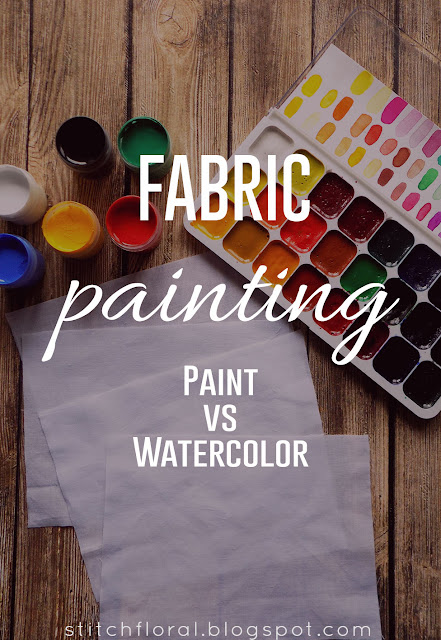

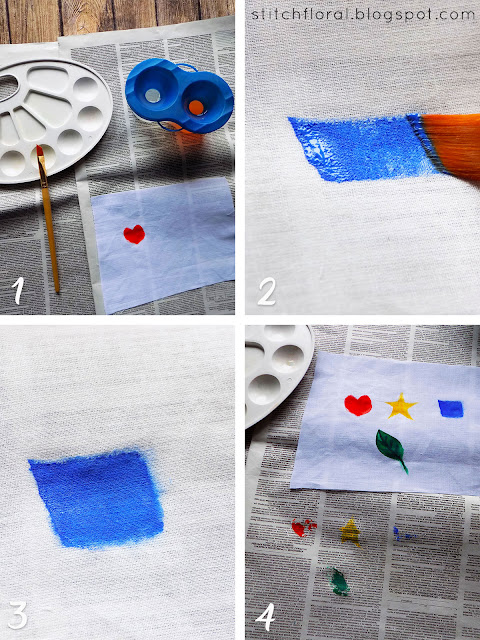
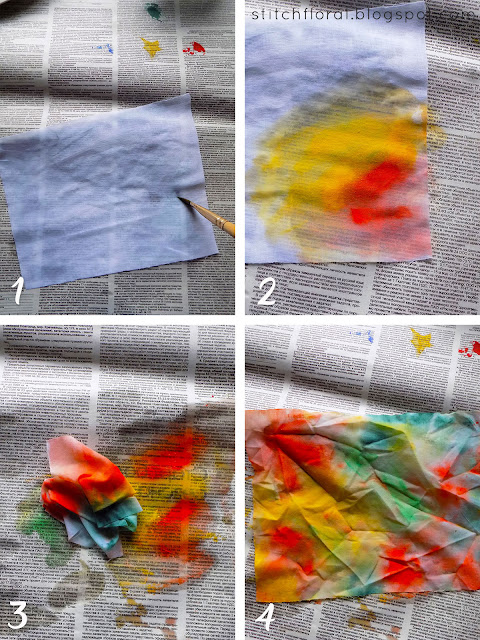
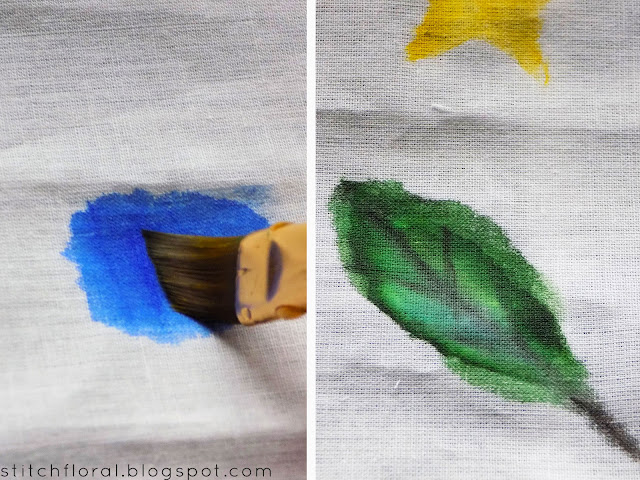


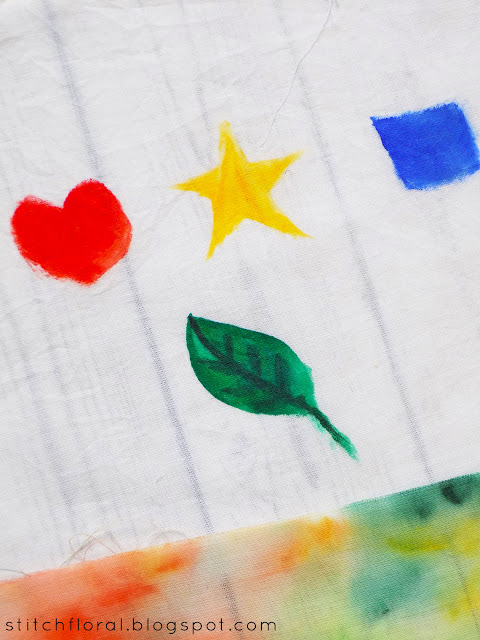













I've heard that ironing watercoloured fabric before washing it will fix the color and keep it from fading as much. Maybe give that a try?
ReplyDeleteOh, that's a good insight! Next time, I can try this method too :)
DeletePurchasing discounted mattresses does not mean a person needs to settle for poor quality, there are many fine quality mattresses available. One only needs to comparison shop using online resources, consumer guides, and recommendations from family and friends to select a fine quality reduced price mattress. Volvo mattress
ReplyDelete